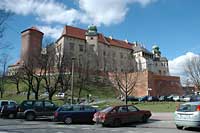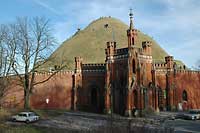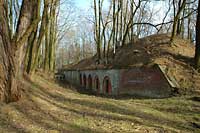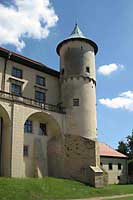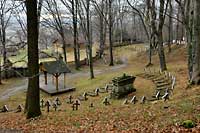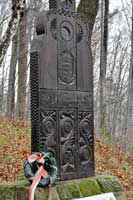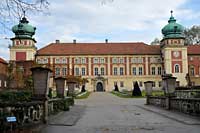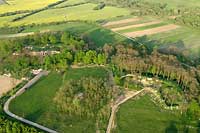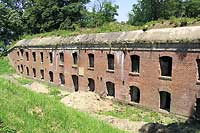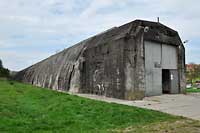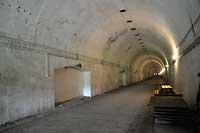THE MILITARY ARCHITECTURE AND WAR MEMORIALS IN POLAND

This historical tour passes through some of the most significant and best preserved fortress complexes in Southern Poland. It follows a route past the military memorials of many centuries but, in particular, visits the citadels, cemeteries and battlefields of World War One.
ITINERARY
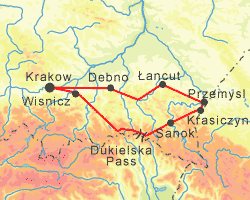
DAY ONE
Arrive in Krakow and transfer to the hotel.
DAY TWO
A guided introduction to Krakow, a city of so rich a cultural and architectural heritage that it was placed on the first list of twelve World Heritage sites by UNESCO in 1978. At the heart of the city is Stare Miasto, the Old Town, once ringed by walls and fortresses. We will visit the remaining fragments of the medieval fortifications (14th -15th century), the Barbican (1498), the King's Way, the Main Market square, and the imposing castle on Wawel Hill where you can trace the development of the fortifications from the Middle Ages to recent times.
DAY THREE
The citadel of Krakow provides a unique memorial to the age of war and fortification. Following yesterday's visits to the internal ring of forts we will spend this morning looking at the external ring, constructed in two stages during the 19th century by August Caboga and General Salis Soglio. They are generally well-preserved, avoiding attack and siege in World War One, although some were demolished in the 1940s and 1950s. In the afternoon there will be a visit to the famous medieval Wieliczka Salt Mines, also placed on the first list of World Heritage sites. Some of the mine chambers were used as a secret military factory by the Germans during World War Two.
DAY FOUR
We leave Krakow to travel by road to Wysowa (150 kilometres), via Wisnicz and Gorlice. At Wisnicz we will see the fortifications constructed in 1615 - 21 by the Italian architect M. Trampola for the House of Lubomirski, the castle which dates from the 16th and 17th centuries, and the 17th century monastery. The Gorlice region witnessed intense, bloody battles in 1914 -15 and the dead are buried in the famous military cemeteries which are now regarded as unique examples of funerary architecture. Wysowa is a resort situated in the rolling, picturesque landscape of the Low Beskidy Mountains and here we will spend the night.
DAY FIVE
From Wysowa we drive through the Low Beskid Range towards the Dukielska Pass, the lowest route across the Carpathians into Hungary. This was the scene of terrible, ferocious fighting in both World Wars, and there are burial grounds for Austro-Hungarian, German and Russian soldiers. During one battle in World War Two more than 86000 Russian soldiers were killed here. Our journey continues via Sanok, where there is a wonderful skansen museum of traditional folk architecture, to Krasiczyn. The striking feature here is the late Renaissance castle, one of the finest in Poland. It was built in 1592 -1614 by Galeazzo Appiani, House of Krasicki, and we will stay overnight in the castle annexe.
DAY SIX
Close to Krasiczyn is Przemysl, the greatest fortress of the old Austro-Hungarian Empire. It is claimed as one of the three largest formerly fortified cities in all Europe, the others being Antwerp and Verdun. At Przemysl there were two rings of forts. The inner polygonal ring, fifteen kilometres in circumference with six main forts, was constructed between 1853 - 55. The outer ring was no less than forty-five kilometres in circumference, with fifteen main and twenty-eight auxiliary forts, and was built between 1878 and 1914. During World War One Przemysl was besieged by the Russians during the winter of 1914 -15. Lack of food forced a capitulation by the inhabitants in March 1915, but not before they blew up most of the fortifications. Those parts which remain provide an impressive illustration of the development of military architecture during the 19th century up until World War One.
DAY SEVEN
We leave our base at Krasiczyn and head first to Lancut to visit the 17th century castle, in the style of 'palazzo in fortezza'. Around forty of the castle's splendid rooms are open to view, and there is also a marvellous collection of carriages here. By contrast our next stop is at Stepina, an underground maze of bunkers and long tunnels adapted for freight trains in World War Two. Hitler met Mussolini here in 1941. We journey on to Debno, near Tarnow, to see the very well preserved Gothic defensive castle, and then return to Krakow for the final night of the tour.
DAY EIGHT
Departure from Krakow. Express trains to Warsaw, if required, take under three hours.
ESSENTIAL INFORMATION
ACCOMMODATION
We stay in comfortable hotels or rest-houses sharing two-bedded rooms with private facilities. Single supplement available on request.
MELAS
Full board from arrival in Warsaw (dinner) to breakfast on the last day. Packed lunches will be provided where restaurants are unavailable.
TRANSPORT
A comfortable coach throughout.
GROUP SIZE AND STAFF
Maximum twenty, accompanied by EkoTourist's tour escort and local experts/guides.










